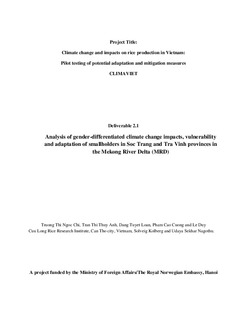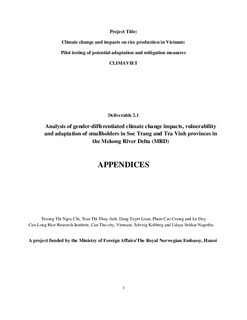| dc.description.abstract | The objective of this study is to better understand socio-economic and gender-differentiated impacts and perceptions of climate change in rice farms in Southern Viet Nam. Focus group discussions and a household survey of both male and female farmers in 160 households were conducted in four villages of Soc Trang and Tra Vinh provinces. These coastal provinces are located at the mouth of the Mekong delta in southern Viet Nam, an area highly at risk of climate variability and climate change causing exacerbating problems of saline intrusion and drought episodes. The survey found that the farm households heavily relied on rice for their livelihood, and that rice contributed to 79 % of the farmer’s total income. In the last 10 years, 95 % of the Soc Trang households and 89 % of the Tra Vinh province had experienced damage to their livelihoods due to salinity and/or drought. The residents in Soc Trang and Tra Vinh province are mostly Khmer ethnic, followed by Kinh (Vietnamese) people. Most of the households are rice farmers, having their own lands. Husbands are generally the household heads and the landowners, and they little education, but in general more educated than women. Both male and female farmers perceived the existence of climate change and variability and recognized its adverse impacts on crop production, animal husbandry, and fishing, as well as other household activities. Low crop yields, and even occasionally total crop losses were rated as the major impacts, leading to increased debt and food insecurity. Farmers coping strategies included change of rice varieties; leave land fallow during severe drought; change of the cropping pattern; more cash crops; and off-farm work. Women not only did the same tasks as men in farming traditionally but also contributed to seed preparation, replanting, hand weeding, removing off types, drying and sacking. Womens’ workload inn recent years increased more than that of men due to climate variation. It was found that male farmers are more likely than female farmers to adopt technologies that can reduce vulnerability to climate change. These technologies included the use of stress-tolerant crop varieties; planting of early, medium or late varieties to avoid crop loss to variations in presence of drought/salinity; pest and disease management techniques; and development and use of crop varieties resistant to pests and diseases. Both female and male farmers had equal access to credit and money loans in the periods of extreme weather events. Moreover, female farmers tend to spend less money, and they stored food to cover basic needs, while male farmers are used to seek wage labor or migrate. The respondents, especially women, reported a lack of adequate extension and technical information about how to cope with agriculture under climate variability. Thus, in situations of salinity and drought, rice farmers reverted to traditional practices with low rice yield outputs, and the Benefit-Cost Ratio (BCR) varied from 1.2 to 1.6 only. Given the important role of women in rice production , rural extension should not ignore women farmers in the development of the extension programs related to agriculture adaptation and climate change. Moreover, mitigation measures should address the needs of both men and women, and ethnic people living in the areas affected by climate change. Any new adaptation measures have to be simple, help in reducing GHGs, low cost and easily adaptable, since majority of farmers are small or marginal landholders with little education and low investment capacity and the government does not have adequate resources. | nb_NO |

